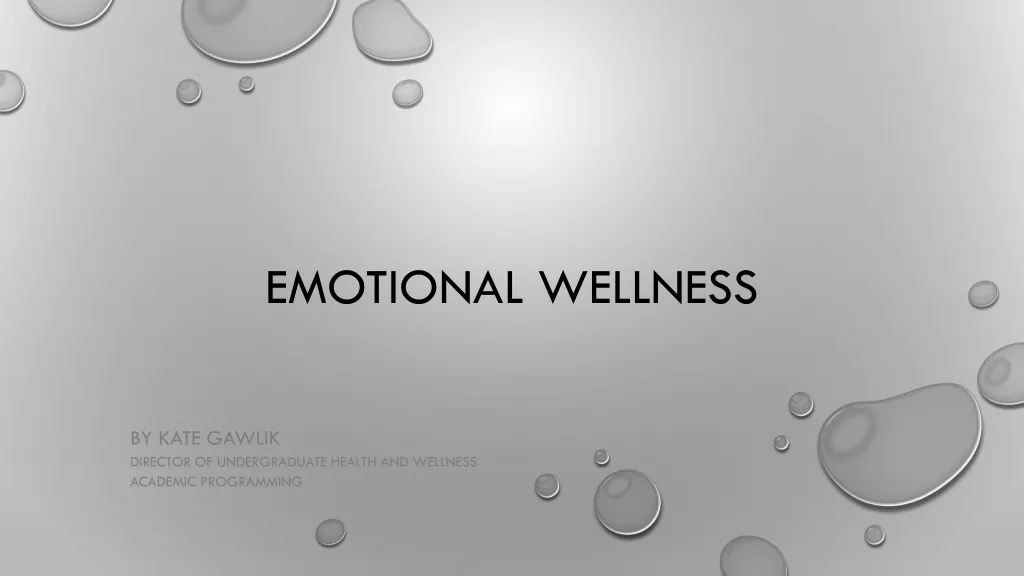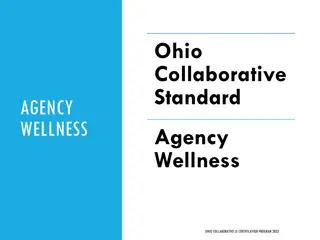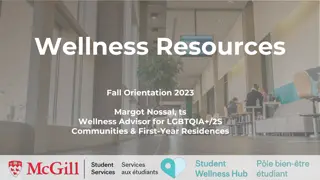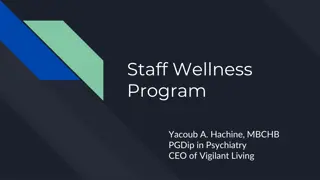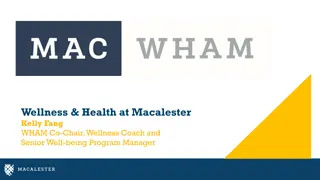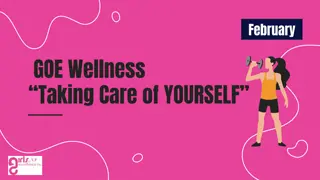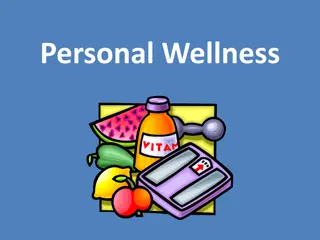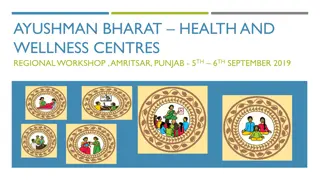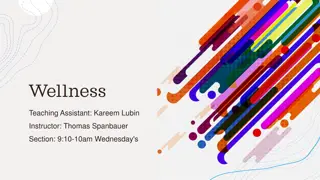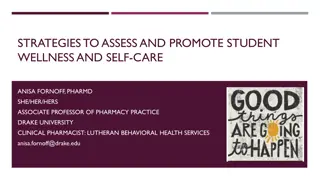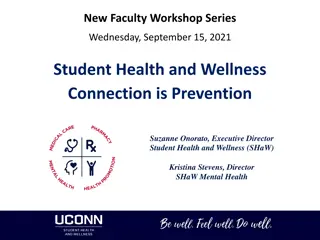
Wellness: Key Concepts and Program Recommendations
Explore the journey of The Wellness Project, driven by the Law of Esprit to promote personal renewal. Delve into the background, discussions, and definitions of wellness within the Bonner Network, focusing on well-being, thriving, and resilience.
Download Presentation

Please find below an Image/Link to download the presentation.
The content on the website is provided AS IS for your information and personal use only. It may not be sold, licensed, or shared on other websites without obtaining consent from the author. If you encounter any issues during the download, it is possible that the publisher has removed the file from their server.
You are allowed to download the files provided on this website for personal or commercial use, subject to the condition that they are used lawfully. All files are the property of their respective owners.
The content on the website is provided AS IS for your information and personal use only. It may not be sold, licensed, or shared on other websites without obtaining consent from the author.
E N D
Presentation Transcript
The Wellness Project: A Discussion of Key Ideas and Programmatic Recommendations Prepared by Eric J. Hearst for The Corella and Bertram F. Bonner Foundation Princeton, New Jersey
The single overriding objective in wellness is creating constant personal renewal where we recognize and act on the truth that each day is a miraculous gift, and our job is to untie the ribbons. That's the Law of Esprit: living life with joy. - Greg Anderson American Author
Background of the Project Phase One: Fall 2016 Bonner Foundation Administrative Leadership began having conversation with partner schools about potential concerns with the overall well-being of students in the Bonner Program Phase Two: Winter 2017 Telephone interviews were conducted with a small sample (6 total) of representatives from Bonner schools. Three specific questions were asked of each of each representative. Responses to the questions were collected and themes identified. Phase Three: Summer 2017 Results of the telephone interviews were presented at the Summer Leadership Institute (SLI) at Lindsey Wilson College. An extended conversation was held at the SLI about wellness within the Bonner network. Responses from the conversation were recorded and themes were identified.
What Do We Mean When We Say Wellness?
Defining Wellness in the Bonner Network? Examples of Wellness Definitions Flourishing (Keyes, 2007) Well-being (Diener, 2000) Wholeness (Long, 2012) Thriving (Schreiner, 2010) Identity (Magolda, 2003) Source: Connecting the Holes to Produce a Whole: Student Well- being as a Unifying Factor Jill N. Reich (professor, Psychology, Bates College and Project Scholar, BTtoP) https://www.aacu.org/sites/default/files/files/CLDE/BT toPWellbeingInitiative.pdf
Defining Wellness in the Bonner Network? Continued The term wellness, as used in the Bonner Network, encompasses three components: Well-being: Refers to characteristics of positive mental health that are measured by purpose in life, supportive social relationships, feelings of efficacy, and optimism about the future (Checkoway, 2011). Thriving: Refers to well-being in multiple areas - physical, emotional, social, and psychological. It involves wisdom, appreciation of wonder, and being able to bring purpose and compassion into your life (Huffington as cited in Hayes, 2015). Resilience: The process of adapting well in the face of adversity, trauma, tragedy, threats or significant sources of stress such as family and relationship problems, serious health problems or workplace and financial stressors (American Psychological Association, 2017).
Defining Wellness in the Bonner Network The Six Dimensions of Wellness Model Dr. Bill Hettler, National Wellness Institute sixdimensionsfactsheet.pdf Occupational: satisfaction and enrichment in one s life through work. The occupational dimension recognizes personal Physical: The physical dimension recognizes the need for regular physical activity. Physical development encourages learning about diet and nutrition while discouraging the use of tobacco, drugs and excessive alcohol consumption. Social: The social dimension encourages contributing to one s environment and community. It emphasizes the interdependence between others and nature. Intellectual: The intellectual dimension recognizes one s creative, stimulating mental activities. Spiritual: The spiritual dimension recognizes our search for meaning and purpose in human existence. Emotional: The emotional dimension recognizes awareness and acceptance of one s feelings. Emotional wellness includes the degree to which one feels positive and enthusiastic about one s self and life.
Why Are We Having This Conversation About Student Wellness?: A Tale of Two Questions 1. Why is wellness important to higher education? 2. Why is wellness important to the Bonner Network?
A Tale of Two Questions Q1a: Why is student wellness important to higher education? 2006 Statistics* 17.5 million university students in the United States 8.5% sought counseling through their school service An additional 29% received services from college-based counselors in other settings 90% of counseling center directors believe they are treating increasing numbers of students with severe pathology 7.5% of students had serious impairments that impeded their ability to function in college settings or without extensive psychiatric or psychological support Source: *The American College Health Association Survey Schwartz and Kay, 2009 - The Crisis in College and University Mental Health https://www.jedfoundation.org/psychiatric_times_the_crisis_in_college_and_university_mental_health/ .
A Tale of Two Questions Q1a: Why is student wellness important to higher education? 2009 Statistics* 13% of students surveyed reported having symptoms of anxiety and more than 18% reported experiencing symptoms of depression Nearly 15% had received a diagnosis of depression sometime early in their lives 25% reported having problems with their studies as a result of sleep problems 33% acknowledged stress-related problems 43% stated that their depression made it difficult for them to function during the academic year 10% had seriously considered suicide 1.9% had actually attempted suicide Source: *The American College Health Association Survey Schwartz and Kay, 2009 - The Crisis in College and University Mental Health https://www.jedfoundation.org/psychiatric_times_the_crisis_in_college_and_university_mental_health/.
A Tale of Two Questions Q1b: Why is student wellness important to higher education? Statistics: Reporting period September 2011 - August 2012* Anxiety is the top presenting concern among college students (41.6 percent), followed by depression (36.4 percent) and relationship problems (35.8 percent). On average, 24.5 percent of clients were taking psychotropic medications. However, 19 percent of [campus counseling center] directors report the availability of psychiatric services on their campus is inadequate. Directors report that 21 percent of counseling center students present with severe mental health concerns, while another 40 percent present with mild mental health concerns. Source: *The Association for University and College Counseling Center Directors Annual Survey American Psychological AssociationCollege students mental health is a growing concern, survey finds http://www.apa.org/monitor/2013/06/college-students.aspx
A Tale of Two Questions - Continued Q1c: Why is student wellness important to higher education? Student wellness significantly impacts the following: Attrition: Students failing to reenroll at a particular institution Dismissal: Students not permitted to continue enrollment (by the institution) Dropout: Students failing to complete degree programs and leaving institutions Persistence: Students demonstrating desire and actions indicative of earning a degree from a post-secondary institution. Retention: An institution s ability to keep a student from admission/enrollment to graduation. Stopout: Students temporarily leaving the institution. Source: Grizzell and McNeil, 2007 Linking Health to Academic Success and Retention https://und.edu/health- wellness/healthy-und/linking-health-to-academic-success-retention.pdf
A Tale of Two Questions - Continued Q2: Why is wellness important to the Bonner Network? The Bonner Foundation s Organizational and Programmatic Philosophy The motto of the Bonner Foundation is "Access to Education, Opportunity to Serve , and its mission is to transform students, communities, and campuses through service. The Bonner Program is transformational in its design - not only are the students who are directly supported by the program transformed, but also the campuses and communities in which they serve and learn. The program rests on a belief in the holistic development of individuals on and off campus and the need for individual and community wellness. Bonner Program Common Commitments Civic Engagement: Participate intentionally as a citizen in the democratic process, actively engaging in public policy and direct service. Community Building: Establish and sustain a vibrant community of place, personal relationships and common interests. Social Justice: Advocate for fairness, impartiality and equality while addressing systemic social and environmental issues. International Perspective: Develop international understanding that enables students to participate successfully in a global society. Diversity: Respect the many different dimensions of diversity in our public lives Spiritual Explorations: Explore personal beliefs while respecting the spiritual practices of others.
Bonner Program Common Commitments Six Dimensions of Wellness Occupational Civic Engagement Physical Community Building Social Social Justice Intellectual International Perspective Spiritual Diversity Emotional Spiritual Explorations
A Tale of Two Questions - Continued Q2: Why is wellness important to the Bonner Network? In order for students to commit fully to the mission of the Bonner Foundation they need to be mindful of their own well-being and need for self-care. Wellness is important to the Bonner network because our students must learn how to balance their lives, prioritize their academic, civic, and personal responsibilities, and model productive behaviors in the settings in which they serve and learn.
Summary of Completed Activities
Interview Questions and Related Themes Question 1: What are some of the issues you are seeing with your students? Mental health challenges (Depression, Anxiety, Self-injurious behavior) High School College Transition (Adjusting to campus culture; Lack of racial/cultural connectedness on college/university campuses; Lack of perceived cultural competency in school-based counseling and student support services) Self-efficacy (Poor coping skills; Lack of resiliency; Inability to seek out and follow-through with supportive services on campus) Additional Issues (Financial challenges; Family dynamics; Racial tension on college/university campuses; Housing insecurity; General student well-being and spirituality) Question 2: What support services are available to your students and in the surrounding area? Academic skills centers Counseling Centers Health & Wellness Centers Campus Chaplaincies Challenges (Lack of health insurance/inability to pay for private treatment; Inability to travel to providers (rural, lack of transportation, etc.); Unwillingness to seek help from campus based supports; Concerns about the lack of cultural/racial competency in campus based supports) Question 3: How can the Bonner Foundation and Bonner Network help? Provide trainings (Trauma informed care; Mental health first aid) Continuing education (Topics including self-care, boundary settings for students and enhancing community support for students) Identify best practices from within the Bonner Network (Enhancing student protective factors/minimizing risk factors on campuses) Additional Suggestions (Allocate or identify funding sources to help develop initiatives (symposia, trainings, etc.) about student well-being within the Bonner Network.
Summer Leadership Institute Discussion Questions and Related Themes Q2: Think back over all of the years you've been involved [with Bonner] and tell us your fondest memory Themes (General) Community events and activities in-network Connection Informal Interactions Acknowledgement (Circle Activities at Bonner Retreats) Affirmation Meaningful Discourse Q3: Think back over the past year about the things Bonner did to promote student wellness in its network. What went particularly well? Themes (General) Promoting use of on-campus resources (counseling centers, etc.) Establishing boundaries Acknowledging burnout/compassion fatigue Providing trainings (self-care: completing homework, scheduling free time, meals) Establishing mentor programs in-network (upper class Bonners w/ lower class Bonners) Confidential conversations (1:1 meetings to discuss issues and/or problems) Sponsors being open (Personally open to discussing mental health or emotional challenges; Encouraging people to come forward) Q4: What needs improvement? Themes (General) Familiarizing Bonner students with campus-based supports Hiring more counselors from diverse backgrounds (college/university issue) Making referrals to counseling programs sooner rather than later Preventative measures (Mental health awareness presentations, etc.) Teaching Bonner how to establish and maintain appropriate boundaries Frequently reflecting on the importance of self-care Training of on-campus Bonner staff (Mental Health First-Aid - Building understanding and knowing when to refer for professional help)
Summer Leadership Institute Discussion Questions and Related Themes - Continued Q5: Suppose you could make one change that would make Bonner's efforts at promoting student wellness better. What would you do? Themes (General) Programmatic changes (Incorporate self-care trainings and mental health in meetings) Reviewing the structure and requirements of the Bonner program (hours, tasks, class assignments, etc.) Actively promoting self-care in the Bonner program (Helping Bonners recognize emotional triggers that may arise while completing service projects) Reevaluate the "common commitments" (Wellness needs to be included in the commitments) Acknowledging challenges and celebrating small victories that might not be included in the annual report (graduating against all odds, surmounting personal obstacles while engaged in the work of Bonner) Advocate for a space at the table [host institution] to discuss Bonner's overall importance to student development Provide additional resources (Models, best practices, mini-grants, etc.) Q6: What can each one of us do to make Bonner's efforts at promoting student wellness better? Themes (General) Improve communication with the host campuses (Regarding student wellness matters) Provide additional trainings through the foundation (Mental health awareness; Training scenarios; etc.) Changing organizational language about metal health and wellness (Destigmatization; Prevention focused)
What are the next steps in promoting wellness in the Bonner Network?
"(And by that destiny) to perform an act, Whereof what's past is prologue; what to come, In yours and my discharge - William Shakespeare The Tempest, Act II, Scene I
Recommendations Bonner Program (BP) campus staff should learn (and follow) the host institution s protocol on crisis reporting; e.g. disclosure of suicidal intentions and/or self-injury, issues that require mandatory reporting, a duty to warn, etc. BP campus staff should consult with their immediate on- campus oversight and various offices of student life on when to refer students to college/university wellness programs. BP campus programs should include orientations to school-based wellness supports for their students. BP campus programs should collaborate with their institution s counseling/wellness centers to offer presentations on self-care and well-being to BP students throughout the academic year.






